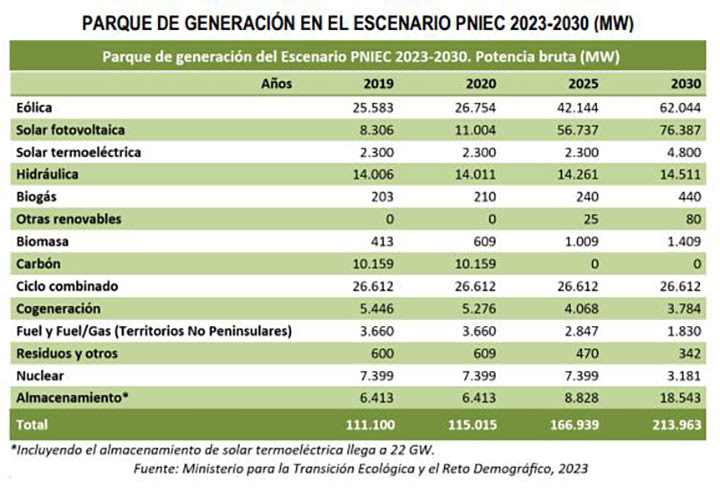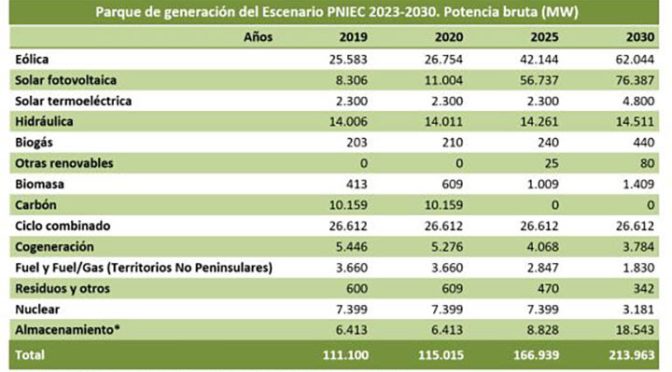Last year, Spain added a renewable generation capacity of 8,400 megawatts to its electricity grid, made up of 5,899 megawatts of wind and photovoltaic energy, and around 2,500 photovoltaic megawatts for self-consumption. This dynamism in the renewable sector has not been accompanied by similar growth in grid infrastructure, resulting in areas where local grids lack the capacity to deliver available energy to consumers, leading to energy spillovers.
The uncompensated reduction of the Spanish electricity network, especially concentrated in Extremadura and the provinces of Ciudad Real and Granada, has led to a million-dollar loss of renewable resources for Spain, aggravated since last 2022. The situation generated by these renewable “discharges” especially affects to photovoltaic and solar thermal energy, and to a lesser extent wind energy. All this at the doorstep of the massive deployment of photovoltaics and wind power to replace nuclear generation, and gas combined cycles on a more distant horizon.

Behind this situation is the slow development of electrical networks and the promised electrification of the economy, from transport to industry, which place Spain at the end of this process in the entire European Union. In fact, in the case of transport, Spain is 7.7 points below the European average and in second to last position, above the Czech Republic and Hungary according to the Anfac motor association with nearly 30,000 charging points in 2023, a increase of a third compared to the previous year, but far from the 45,000 points set as the objective.
A recent analysis by the consulting firm Aurora – made up of some 500 experts linked to the University of Oxford – estimates that around The costs for Spain of the waste of green energy amount to 2.1 billion euros due to a lack of demand and the networks necessary to promote it.
According to the document, the costs associated with technical restrictions have skyrocketed in recent years and some electricity generators risk losing money by reducing their energy production without receiving the necessary compensation.
Aurora Energy highlights that the reduction in renewable production and uncompensated costs began to be significant from May 2022 and reached 1 terawatt hour (TWh) that year, a figure that increased to 1.2 TWh in 2023, the 1.2% of Spain’s renewable production and 18 times more than in 2021 (67 GWh).
Consequently, the cost of these discharges for consumers has skyrocketed in recent years. From an average of 390 million euros annually between 2017 and 2020, it has increased to 800 million in 2021, 1,300 million in 2022 and 2,100 million in 2023. The cost of 2023 means multiplying by 8.4 that of 2019 (250 million) .
The Aurora Energy report highlights that, according to the latest Development Plan for the Electric Energy Transmission Network 2021-2026, the investment in the network will be only 1.9 billion euros, while the congestion of the last three years ( 2020 -2023) amounts to 4.2 billion euros.
Uncompensated discharges or their reduction represented more than 1% of total renewable generation in both 2022 and 2023. However, these reductions vary by location and in some provinces the rates exceed 10%. Thus, photovoltaic solar energy discharges occur to a greater extent in Badajoz, Cáceres and Ciudad Real, with an average of 86 GWh in 2022.
The cuts that affect solar thermal generation represent a high percentage of generation in all provinces, except in Zamora, with an average of 9% in Cáceres, Badajoz and Granada, and 25% of generation in Ciudad Real.
Wind energy is the least affected technology, with 1.6% of total generation in the province with the highest discharges, Zaragoza. The main cause of this waste is that the growth in production is not accompanied by the development of the electric transportation network. To this we must add the lack of public incentives for the electrification of the economy (in the case of the electric car or the replacement of gas with heat pumps in heating) and the numerous taxes they bear. It is also required to accelerate connection plans to neighboring countries to avoid wasting clean energy, essential to achieve decarbonization objectives.
Spills occur when demand is low and the grid cannot absorb more energy at that time. This situation leads the operator of the electrical system, Red Eléctrica, to stop wind turbines or disconnect solar installations, generating economic losses for producers.


